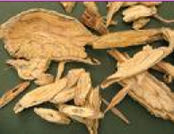Siberian ginseng - Roots
Processing
The thickest roots of the Eleutherococcus plant can reach a diameter of 3-4 cm. As a result fresh Siberian Ginseng roots are often chopped into large pieces after the harvest so they dry more easily.After this the roots are washed thoroughly, sorted and dried at a low temperature. This is done to ensure the level of active ingredients (eleutherosides) remains high. It will keep the internal tissue of the root nice too: it will keep its orderly wood-like color.
 |
Eleutherococcus senticosus is a shrub-like plant with wood-like roots that are used as a cheaper and less powerful alternative for ginseng |
Composition
Despite common belief, it is not always the case that roots with a longer growth period are better than younger roots. The level of active eleutherosides does increase gradually as the root ages, but it is the circumstances under which the plant develops and grows that determine its final eleutheroside level at the moment of harvesting. |
Pieces of the Siberian ginseng roots. |
The distinction between first or second class roots is made mostly based on visual aspects. Roots with a (spots of a) divergent color, some damage or unattractive growth patterns are usually marked 'second choice'. The level of eleutherosides in first and second class roots is equal and so is their strength.
Packaging
Normally any bulk quantity is packed in plastic bags in cardboard boxes or barrels.If desired smaller quantities can be packed in transparent plastic boxes.
Properties
Different parts of the Siberian ginseng roots contain a different content of eleutherosides. The tiny hair-roots contain a 2 to 3 time's higher level of eleutherosides than the main root.Siberian ginseng roots have a somewhat penetrating taste, it is bitter and a bit wry.
The active ingredients in Siberian ginseng roots (eleutherosides) are heat-resistant, and are not damaged or lost in a possible heating process.
Dosage
For optimal therapeutic results of the Siberian ginseng root it is advised to take 2-4 grams daily.When you don't consume the roots as a whole but only make tea from it, a daily dose of 5-10 grams is advised.
The advised amount is higher because after making tea more than half of the eleutherosides will not be extracted and thus remain in the roots.
Practical experiences have demonstrated that activity and effects of Siberian ginseng do not decline proportionally as a daily dose of eleutherosides is lowered.
There is no dangerous maximum daily dose, but 0.5 grams of dried Siberian ginseng root is considered as a minimal daily dose. If you take less than 0.5 grams a day it will most likely not contribute anything.
When mixed with other herbs with active constituents a lower dose of Siberian ginseng might be sufficient.
 |
 |
| previous | next |
